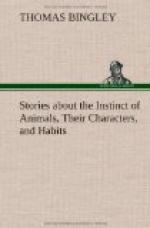“Another manifest provision of nature with regard to these animals is, that the more inhospitable the land is on which they feed, the greater their kindness and attention to their young. I once herded two years on a wild and bare farm called Willenslee, on the border of Mid-Lothian, and of all the sheep I ever saw, these were the kindest and most affectionate to their lambs. I was often deeply affected at scenes which I witnessed. We had one very hard winter, so that our sheep grew lean in the spring, and the thwarter-ill (a sort of paralytic affection) came among them, and carried off a number. Often have I seen these poor victims, when fallen down to rise no more, even when unable to lift their heads from the ground, holding up the leg, to invite the starving lamb to the miserable pittance that the udder still could supply. I had never seen aught more painfully affecting.
“It is well known that it is a custom with shepherds, when a lamb dies, if the mother have a sufficiency of milk, to bring her from the hill, and put another lamb to her. This is done by putting the skin of the dead lamb upon the living one; the ewe immediately acknowledges the relationship, and after the skin has warmed on it, so as to give it something of the smell of her own progeny, and it has sucked her two or three times, she accepts and nourishes it as her own ever after. Whether it is from joy at this apparent reanimation of her young one, or because a little doubt remains on her mind which she would fain dispel, I cannot decide; but, for a number of days, she shows far more fondness, by bleating and caressing over this one, than she did formerly over the one that was really her own. But this is not what I wanted to explain; it was, that such sheep as thus lose their lambs must be driven to a house with dogs, so that the lamb may be put to them; for they will only take it in a dark confined place. But at Willenslee, I never needed to drive home a sheep by force, with dogs, or in any other way than the following: I found every ewe, of course, standing hanging her head over her dead lamb; and having a piece of twine with me for the purpose, I tied that to the lamb’s neck or foot, and trailing it along, the ewe followed me into any house or fold that I choose to lead her. Any of them would have followed me in that way for miles, with her nose close on the lamb, which she never quitted for a moment, except to chase my dog, which she would not suffer to walk near me. I often, out of curiosity, led them in to the side of the kitchen fire by this means, into the midst of servants and dogs; but the more that dangers multiplied around the ewe, she clung the closer to her dead offspring, and thought of nothing whatever but protecting it. One of the two years, while I remained on this farm, a severe blast of snow came on by night, about the latter end of April, which destroyed several scores of our lambs; and as we had not enow of twins and odd lambs for the mothers that




